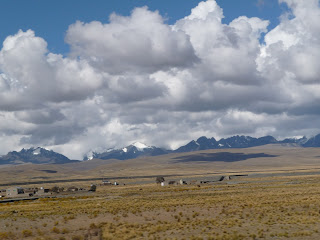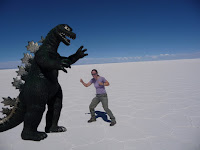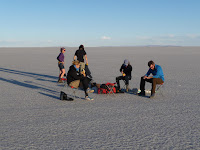Santiago was like a totally different world after the Atacama Desert. We caught the underground metro train from the bus station to our hostal and found ourselves in a city that looked a bit like home (but hotter). To get to our hostal we had to walk past lush green parks, high rise office blocks and several university buildings. Chilli Hostal was fine for the first night, although the free dinner involved an interesting looking beef burger (it was grey/white). I am not sure what we expected for free, but we will not fall for that offer again. However by a stroke of luck the hostal was full the next night and the staff kindly pointed us in the direction of La Chimba Hostal. La Chimba is now our favourite hostal in the whole of South America. It is in the trendy Bellavista area of Santiago, which would normally put us off, but its relaxed atmosphere, comfy sofas, big open spaces and friendly staff make it feel a bit like home. Not to forget Chimbe the resident cat who loves to be stroked. We also felt safe leaving our spare luggage here whilst we went off on various trips. Our first trip was to the Lake District.
We decided the best way to see as much as possible was to hire a car and camp where possible. So we headed out to Santiago airport and picked up a white Chevrolet. Mr Greenhead was driving and I was natigating, which meant I couldn’t doze in the passenger seat and leave the Sat Nav to take us there. Somehow we managed to navigate our way out of the airport, around the ring road and onto route 5 south. The Lake District starts about 500 kilometres south of Santiago, so our first day mainly involved driving. We did stop at some pretty waterfalls just north of Los Angeles (Chile not USA) called Salto de Laja. Then a quick stop in Los Angeles for the supermarket and petrol before heading onto Parque Nacional Laguna de Laja.
As we got nearer to the national park it started to get dark, but we had put the tent up at night plenty of times, so we weren’t worried. However we did start to get a little concerned when every campsite we went past was closed. We knew the main camping season didn’t start until December, but we thought that the campsites might at least be open in November. We finally stopped in Antuca, the last town before the park entrance and the lady who sold us some water assured us the campsite in the park was open. Without any other options we followed her directions and took the bumpy, narrow dirt road to the park entrance and onto the closed campsite! By now it was 10.30pm and a long drive from anywhere, so we decided the only option was to cook ourselves some steak sandwiches and sleep in our car. With the chairs reclined and our sleeping bags to keep us warm it was surprisingly cozy.
We were woken the next morning to sunshine and views of stunning views. We drove further into the park and found a beautiful laguna, snow-capped volcanoes and a tiny ski resort. We also found the park office which said everything opened on the 15th December and after this date the entrance fee is £30. Without a map with hiking trails marked on, we decided to drive on to our next stop – Pucon.
We had to drive a further 300 miles to reach the town and by now were in the heart of the lake district. Pucon is a ski town in the winter and an adventure town in the summer. It is full of outdoors shops, cafés and restaurants. It has a laid back, friendly atmosphere and is very close to a couple of national parks. We found Parque La Poza campsite and set up for a couple of nights – the location was great and it only cost £9 a night, but the toilets were disgusting with freezing showers! We were sharing the campsite with a group of British tourists, who were traveling the length of South America in a giant truck/bus with a company called Oasis Overland (www.oasisoverland.co.uk). The company does tours in various continents and after chatting to one of the girls, we reckon it sounds pretty good.
One of the parks near Pucon is Parque Nacional Huerquehue, so we decided to head here for a hike. The road is paved as far as Laguna Caburgua and then it is bumpy gravel. The gravel road was mostly ok, although we did take a wrong turning and almost got stuck. This could have been a bit of a problem, since we weren’t meant to take our car onto dirt roads. We got to within 3km of the park entrance and came across another steep down-hill section, by now we thought we had pushed our luck enough and decided to park the car by the roadside, then walk the last few kilometres. As luck would have it a bus was passing and gave us a free lift to the entrance gate. After paying our £5 per person entrance fee, we set out on the 5 hour Andean Lakes hike. The hike took us past Lago Tinquilco and up through the forest, with great views of Volcan Villarrica from the lookout points.
We climbed uphill for a couple of hours, then at the top we reached a forest of lush araucaria trees which surrounded several stunningly beautiful lakes. We took a path which looped around Lago Chico, Lago Toro and Lago Verde. Each lake shone and sparkled in the sunshine, giving the place a magical feel . After taking lots of photos it was time to head back, unfortunately no bus passed us this time so we had to walk back uphill to the car.
The other park near Pucon is Parque Nacional Villarrica, which is the reason most people visit the area. At the heart of the park stands Volcan Villarrica which is a 2840 metre high volcano. This volcano is the easiest to climb in Chile and is therefore very popular. Most people hire a guide to climb it, but after our recent ascent of Mont Blanc we decided to climb by ourselves. To enable us to do this we had to hire ice axes , crampons and helmets from Agua Advenutra, the local gear shop (run by 3 French men!). Then at the park entrance we had to show the park warden that we were members of a climbing club and we had insurance. This is the first time we have ever had to prove we were experienced enough to climb a mountain! The route itself up the volcano was very straight forward and we basically had to follow the footprints in the snow left by others. There was a ski lift part way up to save you a bit of walking, but we decided to save our pennies and strengthen our thighs by walking instead.
At the top of the lift there was another guy who checked our equipment again and then we were free to head for the summit. It was snow all the way, but the slopes weren’t too steep and the snow was crunchy, so crampons were not needed. We were lucky that the early morning mist cleared quickly and the sun shone down on us, but colder weather might have meant icy conditions. It took us about 4 hours to reach the summit. The views from the top of other volcanoes were impressive, but the active summit crater was the reason we were here. Whilst we were there the volcano belched out some disgusting sulphurous gases and we had to cover our mouths. It is very strange to see the snow suddenly end at the rim of the crater and you can peer into lava bubbling up out of the depths of the earth.
By the time we had taken our photos and eaten our lunch the sun had gone in. This was good for our decent because the snow stayed crunchy, instead of going slushy. Some people had hired skis to ski down, but we slid down on our bums. It was great fun and only took an hour or so, but our waterproof trousers were a little more worn by the time we reached the bottom.
Our next stop in the Lake District was Lican Ray, a town on the shores of Lago Calafquen. We found a lovely campiste called Cabanas y Camping Foresta, which only charged us £7.50 to pitch our tent and had lovely clean bathrooms with powerful, hot showers. It was another hot, sunny day and the campsite opened out onto the lake, so we decided to go for a swim. I don’t think I have ever swam in such cold water, not even the sea in Scotland is this cold! I think we lasted about 5 minutes. Fortunately we were the only people on the campsite, so no one could laugh at us as we shivered our way back to our tent.
Lican Ray is the gateway to the Siete Lagos (Seven Lakes), a particularly rural part of the Lake District. We decided to avoid going on too many dirt roads and therefore did not make it to each of the 7 lakes, but we did manage to see Lago Calfquen, Lago Panguipulli and Lago Rinihue. All were huge and very picturesque. On route, Mr Greenhead decided to give a lift to a local couple, who were hitch hiking. The only problem was they spoke no English and our limited Spanish meant a very short conversation, followed by silence! To make matters worse the girl looked petrified because Mr Greenhead was enjoying driving round the countries lanes rather fast!
We dropped them off in Panguipulli then left the country roads behind to rejoin route 5 south. We passed the towns of Los Lagos, Osorno and Entre Lagos on our way to Parque Nacional Pueyhue. Just before reaching the park we stopped for an amazing view of Lago Pueyhue.
Parque Nacional Pueyhue has two main entrances - Aguas Calientes and Anticura. We headed to Aguas Calientes first to find out hiking information at the parks office (CONAF) and for a soak in the hot springs. At £5 per person this was the cheapest of the many hot springs in the Lake District region. It is basically a swimming pool filled with very hot water (40°C) that has been naturally heated due to volcanic activity underground. Whilst in there we had an interesting chat with a Canadian girl who is a mountain guide and she recommended some areas for back country skiing when we are in Canada.Next stop was the other park entrance at Anticura, the site of the camping ground and the treks we wanted to do. The campsite (www.anticurachile.cl, £8 a night) was run by a very friendly man, who spoke excellent English and invited us to play a table tennis match with him. We were yet again the only people on the campsite and we soon found out why. The volcano we had come to climb was erupting and had been doing so for 4 months, as a result all the treks up Volcan Pueyhue were closed. Luckily there were other hikes nearby, so we drove to Atillanca ski resort and hiked up Volcan Casablanca instead.
The hike started from a rustic ski club where we had a cup of tea and piece of cake. We followed the ski lifts up, then followed the ridge above the crater and headed for the summit. The slopes start off as scree (loose rocks) then become a mixture of scree and snow. Normally the snow is white but the ash from the erupting volcano meant it had turned grey. The views of Volcan Osorno, Volcan Puntiagudo and Volcan Tronador were also hazy due to the ash that was spewing out of Volcan Pueyhue. You could actually see the volcano erupting, but fortunately the wind was blowing the opposite way so we didn’t get covered in ash. We took a quicker but steeper route down to the crater, then followed the road back down to the car.
That night the wind changed direction and we woke up to find our tent and car covered in ash. The tent was now grey instead of green! There was also ash falling from the sky, which is not good to breath in, so we packed up quickly and left. Our next destination was to be Parque Nacional Vicente Perez Rosales near Petrohue. We drove past Lago Rupanco and Lago Llanquihue on the way. We hoped to camp at the park, but the campsite was shut due to a rat infestation! However we did hike along Paso Desolation to get great views of Lago Todos Los Santos and Volcan Osorno.
After leaving Petrohue we headed for Puerto Varas, the most southerly point in our trip. We had intended to camp here but they wanted £25 a night, which was very expensive. So instead we stocked up at the supermarket and started our journey north. We started to lose the light about 9pm and happened to be near the city of Valdivia. According to our Lonely Planet guide book there was a campsite (Isla Teja) on the edge of town, so we followed their instructions and headed for it. Unfortunately their distances were not too accurate, but after a lot of driving around we found it and were yet again the only people camping. The weather really was pretty mild, but I guess too cold for Chileans to camp. We spent the next morning washing our tent to get rid of the ash, much to the amusement of some old ladies who were staying in the wooden cabins.
We hit the road north again for another 200km until we reached Curacautin, the gateway to Parque Nacional Conguillo. According to our guidebook there was a campsite and a great hike near Lago Conguillo. The guide book didn’t mention that you would need a 4x4 car and rally driving skills to get there. In a moment of madness we decided to go for it and hope that our car and Mr Greenheads driving skills would cope – which they did! However we never reached the lake because the road was blocked by snow at the park ranger s station. Fortunately there was a campsite open on the way back to Curacautin. It was run by a very patient lady who let us practice our very basic Spanish – we managed to discuss our trip, the weather and order some bread!
Our final 500km drive north took us from the drizzle of Temuco to the bright sunshine of the Cajon del Maipo, east of Santiago. The only campsite we could find open was £30 a night, so we decided to treat ourself to a cabana (wooden chalet). The one we chose was run by a gaggle of crazy ladies who were midway through building them. They gave us a discount to make up for a broken tv and settled us into our tiny little cabin/shed! Whilst Mr Greenhead cooked dinner I went for a shower, only to discover freezing cold water. Then to make matters worse I had to climb out the window because they had put the door on back to front, which meant you were locked in! It turned out they hadn’t connected up the hot water, so they moved us to their luxury big house!
The Cajon del Maipo Valley was a bit of a disappointment after the beauty of the Lake District, even the hot springs at Banos Morales didn’t look as good. There was a hike up the El Morado valley but the cloud and drizzle put us off – we had been spoilt by great weather in the Lakes. Though we did manage to find a campsite for our final night, just outside San Jose de Maipo, which sold cold beer and had a tap for us to scrub our rather muddy car! The Cajon del Maipo is where people from Santiago go at the weekends, but we were quite happy to head back to the city and the comfort of La Chimba.



























































































